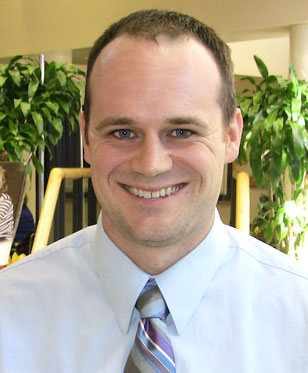Last modified: Wednesday, September 22, 2010
National organization touts School of Education doctoral dissertation tying extra-curricular activity to student success
Higher GPA shows correlation with participation
FOR IMMEDIATE RELEASE
Sept. 22, 2010
INDIANAPOLIS -- The Institute for Education Leadership in Washington, D.C., is citing as a major contribution to the field a study by a recent Indiana University School of Education Ph.D. graduate suggesting a relationship between higher participation in extra-curricular programs and better grades at an Indianapolis community school.
School psychology doctoral graduate John H. Houser's dissertation analyzed participation and grades during the 2008-09 school year at George Washington Community High School (GWCHS), a full-service community school. For that year, the students who had a higher participation rate in extra-curricular activities also had a higher grade-point average.
"There's certainly a relationship going on between participating in these programs both offered by the school and the community and how that relates to how they're doing academically," Houser said.
Last week, the Institute for Education Leadership issued a news release noting Houser's findings. The organization directs the Coalition for Community Schools, which promotes the community school concept. It honored GWCHS with the first National Community School Award in 2006.
The research is important to the GWCHS, a once-closed school that re-opened in 2000 with the help of 17 different entities at Indiana University-Purdue University Indianapolis. The community school model makes the school a neighborhood hub, providing youth and family support services after school and on weekends and partnering with the neighborhood residents as vital support for student success.
The Center for Urban and Multicultural Education at the IU School of Education at IUPUI is a strong collaborator with GWCHS. Monica Medina, faculty member in teacher education at the School of Education, oversees an early field experience for teacher education majors that is part of the partnership. As many as 60 student-interns work in the schools for 14 weeks each semester.
Houser found participation rates varied by race/ethnicity and gender, with one group participating at a higher level and showing a higher grade-point average.
"It's really the Hispanic males who are involved in lots of programs and really doing well academically," Houser said. African-American and Caucasian males participated at lower rates and had lower rates of academic achievement, with no significant difference among females.
Typically, Medina said, educators hear that Latino males are dropping out or are not doing significantly well.
"So, there's something happening at the school," she said.
Houser also found that rates of participation in community-sponsored extra-curricular programming were "very high," indicating efforts to encourage participation in community programs delivered in collaboration with the school succeeded. Seventy-five percent of the student population in grades 7-12 participated in at least one community-sponsored extra-curricular activity.
Houser said more research on other potential factors on student achievement at the school should be investigated to find all possible links. Medina agreed that the data presents part of the picture.
"I can't say that it's directly connected to the afterschool programs or the community school programs," she said. "I think they're just one of many factors that we need to consider."
"Dr. Houser's findings indicate that our partnership efforts in providing after-school activities draw a significant proportion of the student population, the participation makes a difference in academic performance and, despite national trends, the school community is doing something right for traditionally underserved students, notably Hispanic males," Clark Lienemann, executive director of the school's lead-partner collaborating agency, Mary Rigg Neighborhood Center, said in the Institute for Education Leadership news release.
Moving forward, Houser, who now works at Riley Children's Hospital in Indianapolis, said that further examination of extra-curricular participation should be a focus.
"That's something that needs to be investigated: Is this a George Washington phenomenon or is this an Indianapolis Public Schools phenomenon?" he said. "That would help see whether this is related to our community school model or if this is something unique to our community here in Indianapolis."

